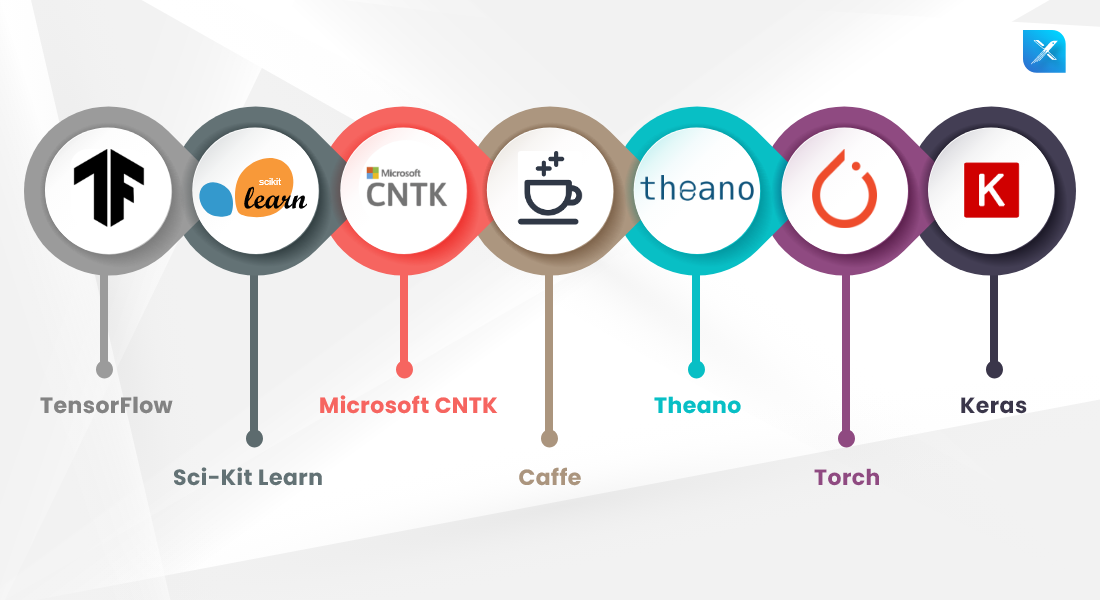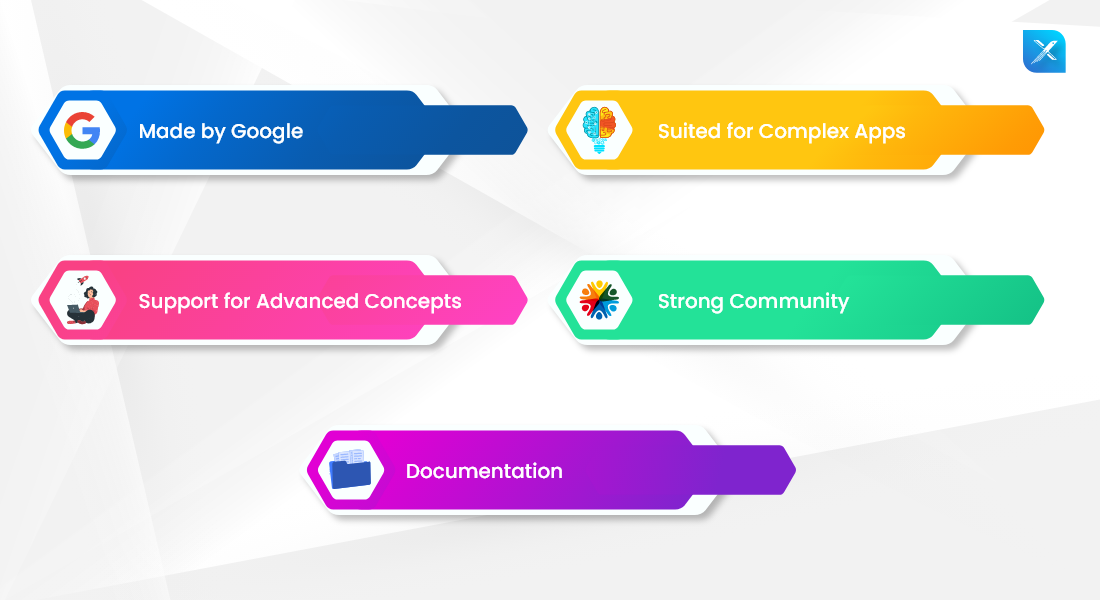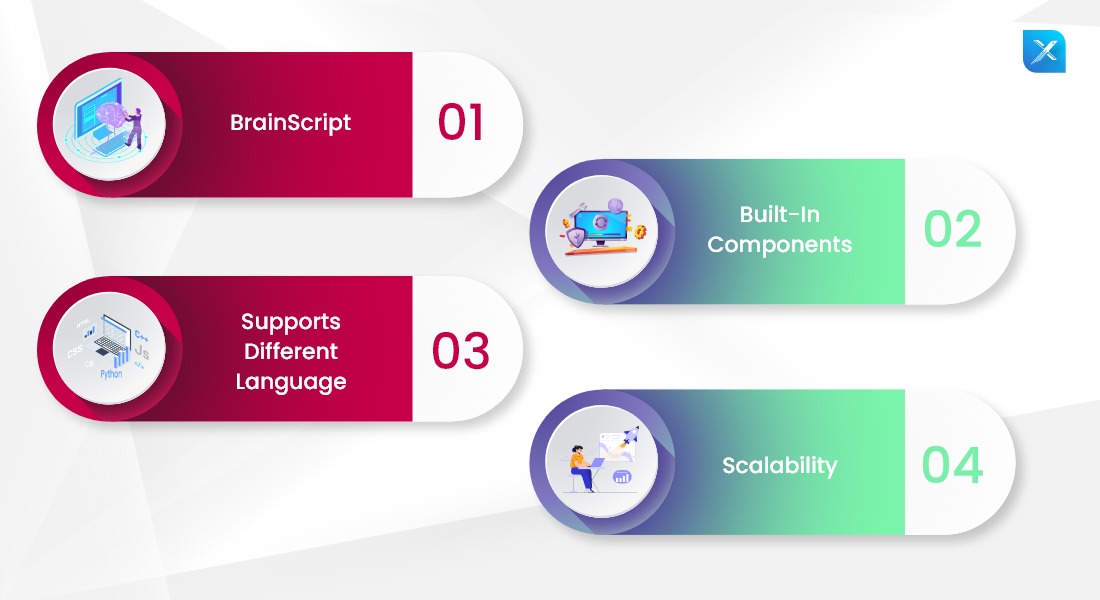FinTech App Development Cost in...
July 7, 2025

Artificial Intelligence has spread to almost every industry and sector. It has a lot of applications and has the potential to build high-quality inclusive solutions aimed at improving how we live, communicate, interact, enjoy, work, and engage.
As you build AI-enabled applications, it requires a deep understanding of the technology and its implementations. AI app development has become a mainstay of modern digital solutions creation integrated with the latest features and functions to help the users get an immersive experience.
AI development services are easier said than done as it involves a deep-set understanding of development methodologies. As a result, the developers employ frameworks catering to AI app development.
Frameworks help speed up the development process and help create the required solutions at cost-effective prices. Let’s find out the best frameworks for AI and machine learning development tasks you can employ to stay ahead with the technological trends in 2022.

Regarded as one of the best open-source frameworks for AI development, TensorFlow belongs to the Google Family. This framework has several in-built systems to help you add features connected to machine learning and other advanced technologies. TensorFlow is based on JavaScript and is one of the leading frameworks of this language.

| Pros | Cons |
| TensorFlow is compatible with Python and C++. Both of these are popular programming languages having advanced capabilities and community support. | TensorFlow needs to pass data through multiple nodes for making a decision or a prediction. This takes a lot of time. |
| This framework for AI app development has potentially high computational power. Due to this, it will support CPU or GPU. | Artificial Intelligence has several pre-trained models, and TensorFlow does not support the majority of them. |
Sci-Kit Learn is a specialist framework for artificial intelligence and machine learning development. It is also used in the form of a Python library. Majorly, Sci-Kit is used to build application models with expertise in statistical modeling like classification, regression, and clustering. Going beyond, Sci-Kit also supports dimensionality reduction, preprocessing, and model learning.
With this framework, you can complete both supervised and unsupervised machine learning development while integrating artificial intelligence capabilities.
| Pros | Cons |
| Scikit-Learn is built for building applications serving real-world purposes, and it has the features meant to complete the same. | This AI framework is not suited for very deep learning solutions. |
| The developers work with an extended amount of API documentation, making it easier to include different algorithms. | Even though it is compatible with GPU, Scikit-Learn is not very efficient with it. |
Another open-source toolkit for AI app development, CNTK, is built by Microsoft. The word in the town is that Microsoft CNTK is the response to Google’s TensorFlow. The best part about this framework is that it supports computational heavy datasets and algorithms to build robust solutions for different industries.
Compared to other frameworks on the list, Microsoft CNTK is faster and versatile. It’s compatibility with neural networks helps developers include features that provide voice, text, and message remodeling.

| Pros | Cons |
| Microsoft CNTK is a highly flexible development technology supporting distributed training. | Microsoft CNTK does not have support for mobile ARM support. |
| Due to its compatibility with Python, we can use Microsoft CNTK on multiple servers leading to faster and quicker learning. | Even though it is fast and scalable, CNTK does not have the desired visualization support. |
That’s a great name for a framework to build AI-based applications, isn’t it? Sometimes coffee and Caffe are the only two things developers need to provide AI development services having pre-loaded neural networks. That’s not it; these neural networks are pre-trained to build smart and efficient solutions.
Besides typical neural networks, it also supports Convolutional Neural Networks (CNN) and has impressive image processing capabilities. Working with Caffe may feel like it lacks the required elements for complex data handling. But what it lacks in data is compensated in terms of speed and processing.
| Pros | Cons |
| We can interlink Caffe with C, C++, and Python and have additional support for CNN (convolutional neural networks). | In AI app development with Caffe, one thing you will miss is its inability to handle complex and data-intensive tasks. |
| Caffe is built to handle tasks with speed and efficiency. | Although Caffe has an impressive support structure, it lacks support for new architectures. |
Theano is a Python-based AI app development framework and is considered a strong contender of Google’s TensorFlow. Among its other features and capabilities, Theano’s ability to handle multi-dimensional arrays and numeral operations with efficiency stands out.
Such operations (multi-dimensional arrays) require high power capacity, and Theano is one of the best platforms for this. Moreover, Theano’s support for Python also makes it faster in terms of processing and responsiveness.
| Pros | Cons |
| Theano is effectively optimized for CPU and GPU-based processing leading to completing numerical tasks with speed and efficiency. | The extended support for data-intensive applications is there, but that requires integration with other libraries. |
| It offers extended support for all kinds of data-intensive applications. | While using Theano on AWS, the developers have faced some bugs. |
Another one of the AI app development frameworks popularly used in the industry, Torch, is known for its ability to complete numerical and scientific operations. Using Torch, you can build clean coded algorithms that can perform the intended functions with speed, reliability, and accuracy.
| Pros | Cons |
| Torch is highly flexible when it comes to language support and integrations with other libraries. | Torch is relatively difficult to learn among other AI app development frameworks. |
| For effective data training, you can find pre-existing models. | You won’t have ready access to code structures for using it immediately. |
Keras is a unique app development technology meant for AI and machine learning solutions. It’s unique because we cannot clearly identify it as a framework. Rather, Keras is an API meant to be used by humans and less by machines.
Abstraction Level: Keras has a high level of abstraction, making it more user-friendly and can be extended easily to configure neural networks. The best part is that Keras can be integrated regardless of the framework.
Add New Modules: With Keras, developers can add new modules to improve the development layers. But adding neural layers and module functions is added with a few restrictions.
Pros and Cons of Keras
| Pros | Cons |
| Keras is a deep Python library and can function as a high-level neural network but in the form of an API. | The biggest issue is that Keras is not a dedicated framework and works as an API. |
| It runs seamlessly with CPU and GPU-based processing systems. | When compared to other technologies in the list, Keras’ data processing abilities are less efficient. |
Artificial Intelligence, Machine Learning, Neural Networks, and other similar innovations are changing the course of our future and the way we build new products and services. While the development languages are primary to this development, these frameworks have made integrating AI and other technologies into an application easier. Hence, to target high-quality creation, we have shared some of the best AI app development frameworks developers can use for their solutions.